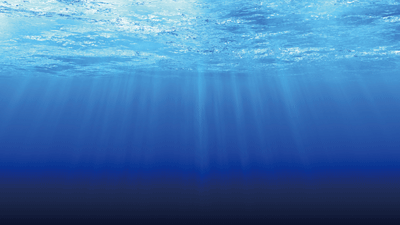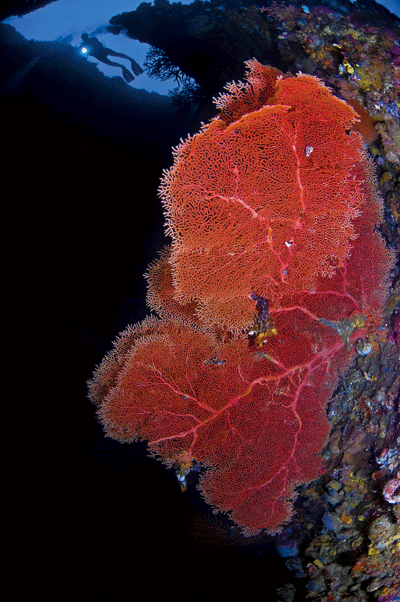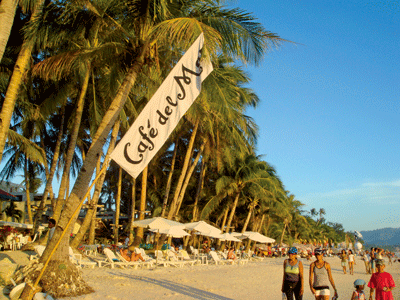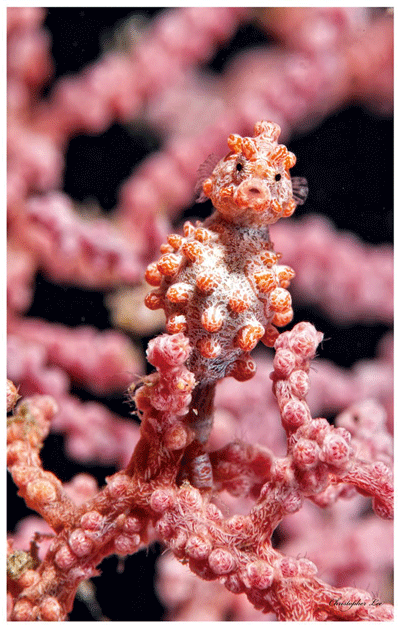There’s no better way to escape the crazy world of honking cars, exploding email inboxes, beeping BlackBerrys and frenzied business schedules than to – quite literally – dive into another world.
When I am underwater and surrounded by a completely different ecosystem, I am forced to slow down, relax and enjoy the liberating sensation of floating free in the middle of a body of water. To really enjoy a dive you have to do everything at a measured pace; I calm my breathing and find a gentle rhythm – something I am not conscious of day-to-day. Once this state of grace is reached, I’m able to really enjoy watching the many extraordinary marine creatures and the shifting colours of the sea. The relative silence is punctuated only by the “bloop, bloop, bloop” noise of the air bubbles bursting from my breathing apparatus, and the occasional clank of metal as my divemaster uses his metal rod to strike his scuba tank in order to attract our attention to something
worth noticing.

When asked how I would describe the underwater world, I say every dive I make is either fascinating, awesome or amusing – often all three at once. Idyllic hotspots such as the Maldives, Seychelles and Caribbean may rightly be held up as dream diving destinations, but here in Asia we are blessed with equally great dive locations, boasting rich marine environments that can fulfil our most indulgent underwater fantasies.

Best of all, many of these locales are easily accessible, affordable and located in centres of beach tourism and hedonistic pleasure that enhance any dive holiday – particularly the mandatory no-fly period at the end of your trip. For me, this enforced dive-free day is a time to chill out, sort through my dive photos, or feast – food being my other favourite pastime. The fact that dive destinations in Asia almost always come with great food is to me just the icing on the cake.
Let me introduce you to four of Southeast Asia’s most popular diving destinations, where the natural beauty both above and below the waterline complement each other perfectly.
Boracay - Party Central
Getting to Boracay can be half the fun. First you fly in to Ninoy Aquino International Airport, then head over to Manila Domestic Airport for a short flight – often by propeller plane – to Caticlan on Panay Island. (Pack your bags carefully, as passengers are often weighed along with their baggage at the airport for all flights into and out of Caticlan, to ensure that the plane is not overloaded.) Next comes a ride on a banca (outrigger) over the clear-blue waters from Caticlan Port to Boracay Port, and finally the quick buzz to White Beach in a motor trike.
There’s no shortage of good accommodation along Boracay’s famous White Beach, and once there, you can choose to enjoy barefoot luxury or slip on some Havaianas (flip-flops) for the duration of your trip. Filipinos really know how to party, so if you’re there during Holy Week, you are in for some great nights out.

Along White Beach, my dive buddy and I signed up with the New Wave Divers operation for a few dives. “Boy” (his real name is Rogelio Lopez Jr) was our divemaster, and he certainly knew how to have fun underwater. We dived straight off our very cool outrigger boat at two sites, Balinghai and Angol Point, and though the day was cloudy, water conditions were perfect, with no surface chop or strong currents. Underwater, there were plenty of distractions for us, with mantis shrimp, nudibranchs, turtles, starfishes, frogfish, Moorish angelfish and other marine creatures, all competing for our attention.
My dive buddy seems to attract the much-feared triggerfish wherever he dives, and it was no different this time around. Luckily, it was not nesting season, or else we would have been spending much of the time avoiding territorial triggerfish, which protect their sandy nests by attacking anything that comes near, and can give a nasty bite. While we were spared any triggerfish incidents, I was stung by a baby jellyfish, but thankfully, it was only mild. Out at Friday’s Rock and in shallower depths, we were treated to some lovely coral reefscapes populated by their colourful marine residents, and even a reef tunnel through which we could swim.
Back on White Beach during my pre-flight no-dive days, I treated myself to servings of chicken inasal, seafood dinners and dessert treats at the many restaurants that lined the beach. Another must-try is the mango shake at Jonah’s Milkshake, where the food is also delectable. It was such a treat too to be able to enjoy a cocktail on the beach and watch the boats come in as the sun set. I highly recommend this therapeutic activity for all jaded city dwellers. If time permits, take a paraw boat tour of the islands as well, and indulge in a pampering massage session at the Mandala Spa. You won’t regret it.
Best time to go: October to December, March to May
Manado - The Real Deal
When it comes to diving in Asia, Manado, near the northern tip of Sulawesi, Indonesia, is known as a dive mecca. On board a flight into Manado, take a good look at the passengers around you and you will notice that many of them sport expensive dive watches and deck themselves out in dive T-shirts and other dive related items. Checking them out, I almost felt privileged to be on the same flight, heading to Bunaken National Park for my diving fix armed only with my own mask and snorkel.
Pre-trip research determined that I would stay with the Sedona Hotel in Manado, home to Minahasa Divers, considered by many divers to be one of the best operators in the region. Over the next two days, Minahasa Divers took us to various sites, including Fukui, Patas Kota, Lekuan III, even to explore the Molas shipwreck. The diving was wonderful, and we never grew tired of the marine life on display, from Moorish idols and pretty anemonefish to flamboyant cuttlefish, blue spotted stingrays, sea snakes and more – though my favourite sighting had to be an up-close encounter with a loggerhead turtle.
It was clear that some fellow divers on our boat were far more experienced than us. During a muck dive – the name given to diving on the less visually splendid muddy bottoms of certain areas – I was hugely impressed by one diver’s ability to handle nearly eight kilos’ worth of camera equipment smoothly and with precision, all for the sake of shooting the fascinating and often bizarre marine life to be found there.
Manado’s water quality and visibility was overall excellent and outstanding, while the rich colours of the marine life gave me some of my best dive photographs ever. Up on dry land at the end of each dive day, the Manado sunset was one I would always remember, its rays glittering on the black volcanic sand before leaving us to tuck into a hearty seafood dinner while listening to the music of the waves on the seashore.
Best time to go: April to October

Lombok - A Trip Back in Time
Lombok may be lesser known than Bali, but in no way is it short of fabulous accommodation, rich local culture, volcano treks and, of course, good dive options.
Flying in to tiny Mataram Airport is like taking a step back in time; airplanes taxi down the single short runway and passengers disembark via mobile stairs before walking across the tarmac into the airport building. A rain shower greeted my arrival, but the attentive airport staff provided passengers with umbrellas. We passed through immigration easily and collected our bags from the only baggage belt, met our driver outside and headed straight for our villa at the Puri Mas Boutique Resort & Spa. We only had a few dives scheduled for the trip – the other activities on the agenda were a pampering visit to the spa and a private Rijsttafel lunch for two.
Win, our divemaster, picked us up at the resort bright and early on dive day, and after collecting our equipment and completing the necessary paperwork, we proceeded to our boat, which took us away from the black-sand beaches of Senggigi towards the Gili Islands, where our dives would take place.
Our sites for the day were Meno Slope and Frogfish, the locations for our wreck dives and reef dives. The variety on show was astonishing, with large dogfish, boxfish, scorpionfish, rays, banded angelfish and garden eels on show – plus, of course, my dive buddy’s nemesis, the triggerfish. Despite the fact that it was supposed to be the best season for diving in Lombok, the currents were fairly strong, which made swimming and finning very challenging and energy-sapping. Even getting out of the water back into the boat felt like an impossible feat – for me at least.
Lombok’s Gili Islands – Gili Air, Gili Meno and Gili Trawangan – are best known for their relaxed and laidback lifestyle. Gili Trawangan is the largest of the three and is also known as the party island, while Gili Air is known to have some good eating places due to its developed local community. We spent our break between dives on Gili Meno and found ourselves very much at home, lounging on deckchairs and basic cabanas on the quiet beach as we were served lunch, then napping a little on its soporific shore before resuming our dives.
We had secretly hoped to spot the mola mola (ocean sunfish) while we were in Lombok, as it was supposed to be the season when it appears. Sadly though we were unlucky, so we will have to come back next season!
Best time to go: May to September, although diving is said to be possible year-round
Phuket - Nice and Easy
Phuket is a year-round destination and easy to get to. Known primarily for its edgy nightlife, great resorts and beach locations, what’s not so widely broadcast is its proximity to some wonderful diving areas.
Many dive locations are within a 90 minutes’ boat ride, and most reefs and dive sites are suitable even for amateur divers. For this reason, it’s not uncommon to find students embarking on dive courses or developing their skills through advanced programmes during their stay in Phuket.
Anemone Reef, also called Hin Jom (Submerged Rock), is just a few hundred metres north of Hin Musang; an underwater pinnacle in deep, open water, it is a fertile environment, boasting coral-encrusted sides and a sandy bottom at deeper levels. Swimming through and around the colourful corals you can find the usual kaleidoscopic crowd of reef denizens, plus highlight species like rays, leopard sharks, moray eels and lionfish to take your breath away.
A wreck dive in Phuket is also a good choice, and thanks to a King Cruiser that sank in 1997 – it hit Anemone Reef near Shark Point – there is now a wreck to explore at convenient depths of 12m to 30m, which makes it an easy dive. Divers are able to explore the vessel’s deck and engine room, and since the wreck has, over time, become home to a variety of hard and soft corals, it now plays host to myriad fish, crabs and other marine life.
It needs to be said, however, that a major draw for diving in Phuket is the sheer number of things to do on land once the dives are over. Restaurants and bars dot Patong beach, and if you’re in need of some peace and quiet, beaches such as Kamala and Kathathani offer respite. Numerous massage options are available to loosen those knotted muscles after your dives, and there’s a plethora of alternative water sports or land-based adventures if you still feel active.
Best time to go: November to April generally, though shifting weather conditions are now making it much harder to predict periods of water clarity. n
Not a Diver yet? And want to be one?
If you, like me, are a time-poor executive who can’t spare the time to head off for complete PADI dive certification at one go from theory to openwater, consider completing just the PADI Scuba Diver Course at home where you will be taken through theory sessions and a practical in the pool. And when you head off to your holidays, complete the Open Water Diver Course on a referral with the divemasters you may engage at your holiday destination.This way, you can kill two birds with one stone.
Prices are relatively similar from region to region – expect Open Water Diver Course to cost around US$600 or if you are going the route of completing the
Scuba Diver Course first before the Open Water dives, expect to pay around US$350 and US$380 respectively.
Contact the dive operators on location directly to pre-arrange, and you may also find yourself presented with
a discount.
The completion of the Open Water Diver Course will present you with a PADI diving certification and a log book to record your future dives.
Boracay www.boracaydiver.com
Manado www.minahasadivers.com
Lombok www.bagusdivers.com/english/english.html
Phuket www.sea-bees.com








